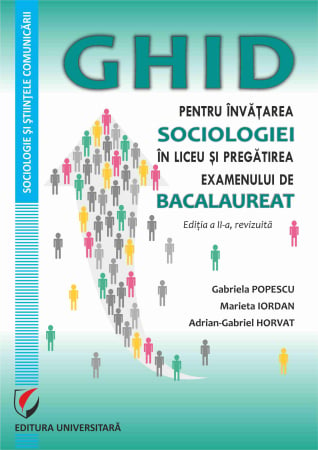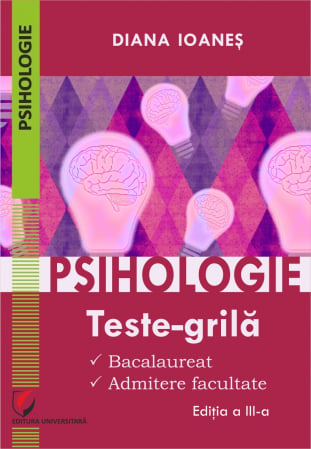ISBN: 978-606-28-0576-0
DOI: 10.5682/9786062805760
Publisher year: 2017
Pages: 142
Publisher: Editura Universitară
Author: Daniela Eugenia Vodita
- Description
- Download (1)
- Authors
- Content
- More details
- Reviews (0)
During this collection, I will bring to your attention models for all types of subjects, thus offering them to students and teachers, in preparation for the baccalaureate exam, auxiliary teaching material in accordance with the school curriculum in force.
-
BACALAUREAT. Tipuri de subiecte la limba si literatura romana
Download
ARGUMENT / 5
TABLE OF CONTENTS / 9
PROPOSED SUBJECTS OF TYPE I / 13
Biographical data of the poets / 15
LYRICAL GENRE / 17
Subject 1/17
Subject 2/18
Subject 3/19
Subject 4/21
Subject 5/22
Subject 6/23
Subject 7/25
Subject 8/26
Subject 9/27
Subject 10/28
Subject 11/30
Subject 12/31
Subject 13/32
Subject 14/33
Subject 15/34
Subject 16/36
Subject 17/37
Subject 18/38
Subject 19/40
Subject 20/41
Biographical data of the prose writers / 43
EPIC GENRE / 45
Subject 1/45
Subject 2/46
Subject 3/48
Subject 4/49
Subject 5/51
Subject 6/53
Subject 7/54
Subject 8/56
Subject 9/57
Subject 10/59
Subject 11/61
Subject 12/62
Subject 13/64
Subject 14/65
Subject 15/67
Subject 16/69
Subject 17/70
Subject 18/72
Subject 19/74
Subject 20/75
Biographical data of the playwrights / 78
DRAMATIC GENRE / 79
Subject 1/79
Subject 2/80
Subject 3/82
Subject 4/83
Subject 5/85
Subject 6/86
Subject 7/88
Subject 8/89
Subject 9/91
Subject 10/92
Subject 11/94
Subject 12/95
Subject 13/96
Subject 14/98
Subject 15/100
Subject 16/101
Subject 17/103
Subject 18/104
Subject 19/106
Subject 20/107
PROPOSED SUBJECTS OF TYPE II / 111
Subject 1/113
Subject 2/114
Subject 4/115
Subject 5/115
Subject 6/116
Subject 7/117
Subject 8/117
Subject 9/118
Subject 10/119
Subject 11/119
Subject 12/120
Subject 13/120
Subject 14/121
Subject 15/122
Subject 16/122
Subject 17/123
Subject 18/124
Subject 19/124
Subject 20/125
PROPOSED SUBJECTS OF TYPE III / 127
Subject 1/129
Subject 2/130
Subject 3/132
Subject 4/133
Subject 5/134
Subject 6/135
Subject 7/136
Subject 8/137
Subject 9/139
Subject 10/140
The subject of examination in Romanian language and literature, the written test, comprises three parts: the first consists in deciphering, understanding and stylistic analysis of a lyrical, epic or dramatic text at first sight; the second part considers the expression of an opinion, starting from a given topic, and the last part involves writing a structured essay, each of these topics, worth 30 points.
During this collection, I will bring to your attention models for all types of subjects, thus offering them to students and teachers, in preparation for the baccalaureate exam, auxiliary teaching material in accordance with the school curriculum in force.
In order to correctly solve the requirements of the Type I Subject, students must have knowledge of the Romanian language (phonetics and lexicology), notions of stylistics and literary theory, provided in the exam syllabus.
The obligatory contents for the first subject are:
- the application, in various communication situations, of the orthographic, orthoepic, punctuation, morphosyntactic norms and the adequate use of the lexicosemantic units;
- the application of language knowledge, including those acquired in the gymnasium cycle, in the correct expression and in the reception of the studied texts or at first sight;
- correct / incorrect pronunciations of neologisms; identification of sound groups (hiatus, diphthong, triphthong), accent;
- cacophony, hypercorrectness;
- nuanced pronunciation / reading of sentences (tone, pause, intonation);
- lexical variants, semantic fields;
- semantic errors: pleonasm, tautology, paronymic confusion;
- derivatives and compounds (prefixes, suffixes, prefixoids, suffixoids), changing the grammatical category;
- semantic relations (polysemy, monosemy, synonymy, antonymy, homonymy, paronymy);
- the correct meaning of words (especially neologisms);
- phraseological units (phrases and expressions);
- semantic fields and their role in interpreting written and oral messages;
- the meaning of words in context: denotative meaning and connotative meaning;
- inflectional forms of the parts of speech (plural nouns, articulation of nouns, casual forms; inflectional forms of the verb; adjectives without degrees of comparison; numerals, etc.); expressive values of the parts of speech; linguistic means of achieving the subjectivity of the speaker;
- elements of grammatical agreement (between predicate and subject - logical agreement, agreement by attraction; agreement of the attribute with the determined part of speech);
- relational elements (prepositions, conjunctions, relative pronouns / pronominal adjectives, relative adverbs);
- spelling and punctuation norms in the constitution of the written message (correct spelling of words, capitalization, division of words into syllables, correct use of spelling and punctuation marks);
- the role of spelling and punctuation marks in understanding written messages;
- stylistic registers (standard, colloquial, specialized, etc.) adequate to the communication situation;
- coherence and cohesion in oral and written expression;
- types of texts and their structure: narrative, descriptive, informative, argumentative;
- functional styles appropriate to the communication situation;
- standard language, literary language, colloquial language, popular language, regional language, archaic language; slang, jargon;
- direct style, indirect style, free indirect style;
- the role of style figures and artistic procedures in establishing meaning;
- the role of archaic and regional elements in receiving messages.

6359.png)
![Baccalaureate Types of subjects in Romanian language and literature - Daniela Eugenia Vodita [1] Baccalaureate Types of subjects in Romanian language and literature - Daniela Eugenia Vodita [1]](https://gomagcdn.ro/domains/editurauniversitara.ro/files/product/large/bacalaureat-tipuri-de-subiecte-la-limba-si-literatura-romana-441-358369.jpg)














